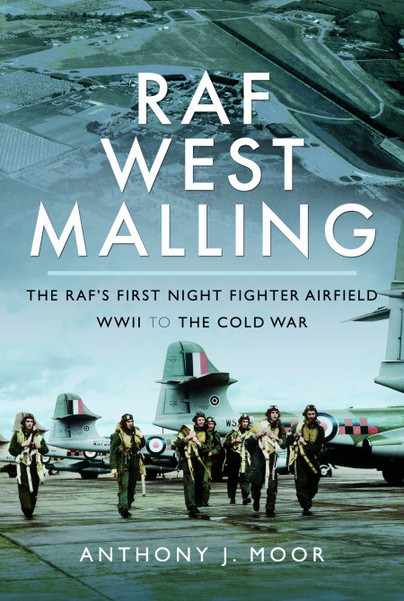RAF Hawkinge (Hardback)
The RAF’s Wartime Frontline Airfield; From Dunkirk to the Battle of Britain and D-Day
Imprint: Air World
Pages: 312
Illustrations: 150+ mono integrated
ISBN: 9781399071468
Published: 21st May 2024
(click here for international delivery rates)
Need a currency converter? Check XE.com for live rates
As the nearest RAF station to Occupied Europe, the airfield at Hawkinge in Kent found itself quite literally on the frontline during the Second World War. However, Hawkinge’s association with British military aviation began more than two decades earlier, during the First World War.
Already a pre-war airfield, it was in 1915 that the land was requisitioned for use by the Royal Fling Corps. The first personnel arrived a few months later to serve at was initially named Folkestone Field. Mainly used as a base for transporting aircraft across to France and the Western Front, a name change to Hawkinge Aeroplane Dispatch Station soon followed, at which point its remit also included the transportation of supplies to troops in France and Belgium.
It was following the re-organisation of the RAF in 1923 that Hawkinge underwent the next stage in its development. New hangars and operations buildings were erected, with water and communications systems installed. The airfield’s role changed to that of training for both RAF and the Army; 25 Squadron was the first full squadron to be based at Hawkinge.
In the first months of the Second World War, airfield was re-designated as a Fighter Station in No.11 Group, following which the first Hurricanes from 3 Squadron arrived on 19 December 1939. Throughout the Battle of France and into the Dunkirk evacuation Hawkinge played a vital role providing around the clock air-cover for Allied forces. But it was in the summer of 1940 that Hawkinge endured its ‘finest hour’.
The first Luftwaffe attack on Hawkinge occurred on 12 August. Despite widespread damage, the grass runways were quickly repaired, ensuring that the Spitfires and Hurricanes which used it as a forward base were soon operating again. Despite the Luftwaffe’s best efforts, Hawkinge remained operational throughout the war.
As the RAF went on the offensive in 1941, Hawkinge had a vital part to play in maintaining these missions against Goering’s forces – both as a location to refuel on the way out, or a place of refuge on the return, both for fighters and bombers alike, including those of the USAAF following America’s entry into the war. Following the war, the fighter base was officially closed on 3 September 1945.
In 1964 the Ministry of Defence sold the land, although for a short while in 1968, memories of the war were invoked with the airfield’s use in the making of the classic film Battle of Britain. Only a small corner of the original site has survived and is today home to the renowned Kent Battle of Britain Museum.
"Recommended."
Flypast - September 2024
"Recommended."
Aviation News - August 2024
"Anthony covers the history of the site in twelve chapters; understandably, the bulk concerns Hawkinge’s role in the Battle of Britain and the rest of the war. He has done much detailed research, also located over 150 period photographs..."
The de Havilland Aeronautical Technical School Association Newsletter No. 89, Summer 2024
As featured
Loopholes, Journal for the Pillbox Study Group - Number 89
"This well written book is more than a dry airfield history but a useful reference of operations through the war years. Recommended."
Andrew Thomas - Author and Historian
As featured in
The Bookseller
About Anthony J Moor
ANTHONY JOHN MOOR was educated at the Royal Naval School, Tal Handaq, Malta GC. On his return to the UK he served a five-year apprenticeship with Hawker Siddeley Aviation, which began at the De Havilland Technical School at Astwick Manor, shortly after De Havilland Hatfield had been taken over by HSA. He later worked in Germany as a draughtsman with AEG Gas Turbines, and engineering companies in the UK. In the 1980s Anthony worked with Metair Aircraft Equipment at West Malling. He is the author of five previous books on former airfields in Kent, namely Brenzett ALG, the Home Defence airfield at Throwley, near Faversham, Detling, Lympne, and Ramsgate Airport, and has written numerous aviation articles. He lives in Ashford, Kent, with his wife.
RAF West Malling The RAF's First Night Fighter Airfield - WWII to the Cold War (Hardback)
This is the story of West Malling airfield, from its earliest days through its role in the Second World War – when several dramatic and tragic events occurred – and beyond into the Cold War. Opened as a private landing ground after the First World War, the airfield at West Malling, then known as Kings Hill, became home to the Maidstone School of Flying in 1930. It was then renamed West Malling Airfield, and, in 1932, Maidstone Airport. The airfield's RAF role came to the fore in June 1940, by when the station had been fitted with a concrete runway. The first aircraft arrived on 8 June 1940.…
By Anthony J MoorClick here to buy both titles for £54.99
















